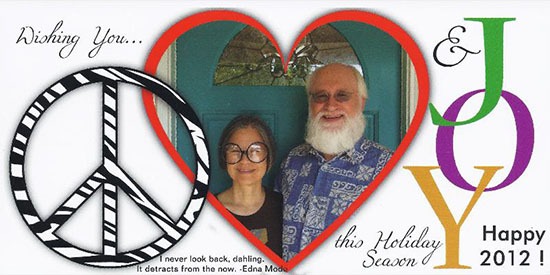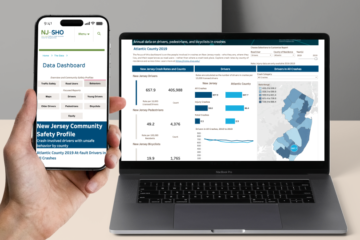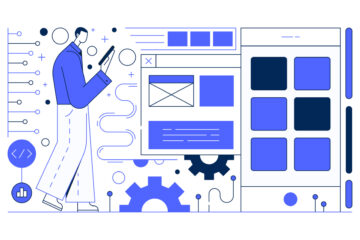We keep this great stack of cards in the dining room: it’s called “TableTopics: Questions to Start Really Great Conversations.” Questions range from “would you prefer to spend money for a housekeeper, a cook, a gardener, or a personal secretary?” to “what life experience has strengthened you the most?” One of my favorites is “who is the most unusual person in your family?” I especially like the fact that it gets everyone to sharing family memories, and inevitably results in wonderful stories about what makes a particular member stand out in those memories.
In our family, the unanimous response to this question is always “Art — definitely Art!” Art, our eldest brother, has led an extraordinarily interesting life and is certainly our most unusual relative — we have the stories and photos to prove it. These two photos of Art and his wife, Cindy, were taken about 40 years apart; I’ll let you use your imagination to create stories about them (adding that in Art’s case, real life is definitely stranger and more interesting than most people could dream up).


I also like the “who is the most unusual person” question because it makes me stop and think about the interesting, real-life people in my world. You doubtless have equally complex and fascinating people in yours — among whom are the ones you create reports and dashboards for. Unfortunately, most people responsible for presenting and interpreting data forget just how interesting — and complicated — the people in their audiences are, and design for a faceless, nameless end-user.
To avoid this mistake, we create and try always to keep in mind what we call personas — fictitious but very real users intended to help us remember the needs of the people for whom we conceive and construct reports, dashboards, and user interactions.
How do personas help?
- By steering us away from self-referential thinking. We the designers and content experts are not like our most characteristic users: our familiarity with the material, and our skill in and enjoyment of manipulating it, actually prevent us from coming at problems and process from the users’ point of view. Personas move us from a provider-centered to a user-centered set of coordinates.
- By keeping teams focused. Thanks to the immediacy and human-ness of personas, instead of continually referring to anonymous “users,” team members connect to live (and lively) personalities among their projected audience, staying focused on what can to be done to make those people’s lives easier, not on how cool a pie-chart (horrors) they can come up with.
- By keeping design consistent, responsive, and needs-appropriate. Personas help align designs with goals: data- display creators return to them as to a touchstone, seeking context, perspective, reassurance that they are on the right track for a particular group of clients. Used effectively, personas return us reliably to the core inquiries: is this what my imagined user needs most? Will this feature or design element make her day easier, her goals more reachable, her patients or her colleagues more comfortable, less stressed, more efficient, happier? Or does it fall into the “bells and whistles” category — fun to dream up and tie on, but distracting or impeding rather than useful?
How do we create and use personas?
- Base them on solid research, with interviews and discussions that fully explore the projected problem(s) or goal(s). Personas should not spring from the imagination; they need to take form and substance from specific ideas gathered from real members of your client’s staff or stakeholders.
- Be able to list concrete, tangible goals to reach and problems to solve, and — most important — how what you do with data presentation will actually move people toward those goals and address those problems.
- Refer to them often. Just as I used photos of Art and Cindy to make them more real for you, create profiles for and look at visual representations of your personas. Give them names, histories, an education; jobs, kids, likes and dislikes. Refer to the profiles often. As you discuss your designs, ask questions out loud: how does this help Marci? How will Marci use this? What does she need? How would she like to interact with our design, and when she does, will she call its elements and features useful tools, or distracting clutter that keeps her from doing her job?
People may laugh at your personas, and even try to dismiss them. Stick with them. The scoffers will get on board when they realize how constructively the presence of that living, breathing client — virtually a member of your team — affects your work. I’ve even seen groups make life-sized photo cutouts for the wall or to prop up in a chair. Personas’ needs and goals are written all over the cut-outs, so that no one can claim to have overlooked them. The point is to loosen up, have some fun — and never forget that we are designing and displaying for real people. Not one of them is named “end-user.”
By the way: meet Marci (below), Hospital Director of Quality.

Marci is a 45-year-old nurse who just completed a master’s degree in management. Marci is new to the director’s position, having just been promoted a few months ago from her previous job as a team leader for performance improvement projects. She is highly skilled at managing the information her department collects and oversees, and she can create spreadsheets and simple ad-hoc reports; but she doesn’t have any formal training in data analysis or visualization.
Marci is becoming increasingly frustrated by spending more time trying to figure out what pieces of data and information her boss refers to during weekly meetings than on running her department. She spends hours poring over piles of data displayed in tables; she can’t remember the last time she ate dinner with her family. The late nights at the office are starting to really stress her out, and she’s having second thoughts about having taken this job.
Marci needs standardized reports and dashboards that display data so that trends and
patterns are easy to see, and that allow her to easily drill down to the bedrock of the data that form the basis of her boss’s monitoring dashboard. She also needs easy access to all of this information via a web page, one that is dynamic and continuously updated so that she has timely information.
Look into Marci’s face — the face of your persona. Then say, “what we’ve designed to display, analyze, and compare data will make your job easier. Right now. Every day.” You can’t let her down; you know too much about what she needs. There’s your challenge — and that’s why a persona can transform both the way you work and the lives of the people you’re working for.



0 Comments